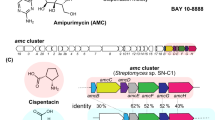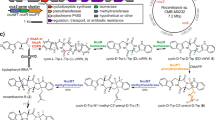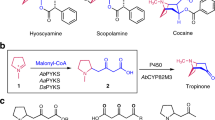Abstract
Phosphinothricin tripeptide (PTT, phosphinothricylalanylalanine) is a natural-product antibiotic and potent herbicide that is produced by Streptomyces hygroscopicus ATCC 21705 (ref. 1) and Streptomyces viridochromogenes DSM 40736 (ref. 2). PTT has attracted widespread interest because of its commercial applications and unique phosphinic acid functional group. Despite intensive study since its discovery in 1972 (see ref. 3 for a comprehensive review), a number of steps early in the PTT biosynthetic pathway remain uncharacterized. Here we report a series of interdisciplinary experiments involving the construction of defined S. viridochromogenes mutants, chemical characterization of accumulated intermediates, and in vitro assay of selected enzymes to examine these critical steps in PTT biosynthesis. Our results indicate that early PTT biosynthesis involves a series of catalytic steps that to our knowledge has not been described so far, including a highly unusual reaction for carbon bond cleavage. In sum, we define a pathway for early PTT biosynthesis that is more complex than previously appreciated.
This is a preview of subscription content, access via your institution
Access options
Subscribe to this journal
Receive 12 print issues and online access
$259.00 per year
only $21.58 per issue
Buy this article
- Purchase on Springer Link
- Instant access to full article PDF
Prices may be subject to local taxes which are calculated during checkout



Similar content being viewed by others
Accession codes
References
Seto, H. et al. Studies on the biosynthesis of bialaphos (SF-1293). 1. Incorporation of 13C- and 2H-labeled precursors into bialaphos. J. Antibiot. (Tokyo) 35, 1719–1721 (1982).
Bayer, E. et al. Phosphinothricin und phosphinothricyl-alanyl-alanin. Helv. Chim. Acta 55, 224–239 (1972).
Thompson, C.J. & Seto, H. in Genetics and Biochemistry of Antibiotic Production (eds. Vining, L.C. & Stuttard, C.) 197–222 (Butterworth-Heinemann, Newton, Massachusetts, USA, 1995).
Abell, L.M. & Villafranca, J.J. Investigation of the mechanism of phosphinothricin inactivation of Escherichia coli glutamine synthetase using rapid quench kinetic technique. Biochemistry 30, 6135–6141 (1991).
Bailey, R.R. Brief overview of single-dose therapy for uncomplicated urinary tract infections. Chemotherapy 36 (suppl. 1), 27–30 (1990).
Missinou, M.A. et al. Fosmidomycin for malaria. Lancet 360, 1941–1942 (2002).
Blodgett, J.A., Zhang, J.K. & Metcalf, W.W. Molecular cloning, sequence analysis, and heterologous expression of the phosphinothricin tripeptide biosynthetic gene cluster from Streptomyces viridochromogenes DSM 40736. Antimicrob. Agents Chemother. 49, 230–240 (2005).
Schwartz, D. et al. Biosynthetic gene cluster of the herbicide phosphinothricin tripeptide from Streptomyces viridochromogenes Tü494. Appl. Environ. Microbiol. 70, 7093–7102 (2004).
Hidaka, T., Hidaka, M. & Seto, H. Studies on the biosynthesis of bialaphos (SF-1293). 14. Nucleotide sequence of phosphoenolpyruvate phosphomutase gene isolated from a bialaphos producing organism, Streptomyces hygroscopicus, and its expression in Streptomyces lividans. J. Antibiot. (Tokyo) 45, 1977–1980 (1992).
Nakashita, H., Kozuka, K., Hidaka, T., Hara, O. & Seto, H. Identification and expression of the gene encoding phosphonopyruvate decarboxylase of Streptomyces hygroscopicus. Biochim. Biophys. Acta 1490, 159–162 (2000).
Schwartz, D., Recktenwald, J., Pelzer, S. & Wohlleben, W. Isolation and characterization of the PEP-phosphomutase and the phosphonopyruvate decarboxylase genes from the phosphinothricin tripeptide producer Streptomyces viridochromogenes Tü494. FEMS Microbiol. Lett. 163, 149–157 (1998).
Hidaka, T. et al. Studies on the biosynthesis of bialaphos (SF-1293). 11. Biochemical mechanism of C-P bond formation of bialaphos: use of gene manipulation for the analysis of the C-P bond formation step. Agric. Biol. Chem. 54, 2121–2125 (1990).
Lee, S.H., Hidaka, T., Nakashita, H. & Seto, H. The carboxyphosphonoenolpyruvate synthase-encoding gene from the bialaphos-producing organism Streptomyces hygroscopicus. Gene 153, 143–144 (1995).
Babbitt, P.C. et al. The enolase superfamily: a general strategy for enzyme-catalyzed abstraction of the α-protons of carboxylic acids. Biochemistry 35, 16489–16501 (1996).
Hara, O. et al. The bialaphos biosynthetic genes of Streptomyces viridochromogenes: cloning, heterospecific expression, and comparison with the genes of Streptomyces hygroscopicus. J. Gen. Microbiol. 137, 351–359 (1991).
Seto, H. et al. Studies on the biosynthesis of bialaphos (SF-1293). Part 3. Production of phosphinic acid derivatives, MP-103, MP-104 and MP-105, by a blocked mutant of Streptomyces hygroscopicus SF-1293 and their roles in the biosynthesis of bialaphos. Biochem. Biophys. Res. Commun. 111, 1008–1014 (1983).
Alijah, R., Dorendorf, J., Talay, S., Pühler, A. & Wohlleben, W. Genetic analysis of the phosphinothricin-tripeptide biosynthetic pathway of Streptomyces viridochromogenes Tü494. Appl. Microbiol. Biotechnol. 34, 749–755 (1991).
Imai, S., Seto, H., Ogawa, H., Satoh, A. & Otake, N. Studies on the biosynthesis of fosfomycin. Conversion of 2-hydroxyethylphosphonic acid and 2-aminoethylphosphonic acid to fosfomycin. Agric. Biol. Chem. 49, 873–874 (1985).
Taylor, P.P., Pantaleone, D.P., Senkpeil, R.F. & Fotheringham, I.G. Novel biosynthetic approaches to the production of unnatural amino acids using transaminases. Trends Biotechnol. 16, 412–418 (1998).
Imai, S. et al. Studies on the biosynthesis of bialaphos (SF-1293). 4. Production of phosphonic acid derivatives, 2-hydroxyethylphosphonic acid, hydroxymethylphosphonic acid and phosphonoformic acid by blocked mutants of Streptomyces hygroscopicus SF-1293 and their roles in the biosynthesis of bialaphos. J. Antibiot. (Tokyo) 37, 1505–1508 (1984).
Potters, M.B. et al. Phosphoprotein with phosphoglycerate mutase activity from the archaeon Sulfolobus solfataricus. J. Bacteriol. 185, 2112–2121 (2003).
Seto, H. et al. Studies on the biosynthesis of fosfomycin. 2. Conversion of 2-hydroxypropylphosphonic acid to fosfomycin by blocked mutants of Streptomyces wedmorensis. J. Antibiot. (Tokyo) 44, 1286–1288 (1991).
Woodyer, R.D., Li, G.Y., Zhao, H.M. & van der Donk, W.A. New insight into the mechanism of methyl transfer during the biosynthesis of fosfomycin. Chem. Commun. (Camb.) 359–361 (2007).
Woodyer, R.D. et al. Heterologous production of fosfomycin and identification of the minimal biosynthetic gene cluster. Chem. Biol. 13, 1171–1182 (2006).
Wanner, B.L. in Methods in Molecular Genetics Vol. 3 (ed. Adolph, K.W.) 291–310 (Academic, Orlando, Florida, USA, 1994).
Martinez, A. et al. Genetically modified bacterial strains and novel bacterial artificial chromosome shuttle vectors for constructing environmental libraries and detecting heterologous natural products in mutiple expression hosts. Appl. Environ. Microbiol. 70, 2452–2463 (2004).
Keiser, T., Bibb, M.J., Buttner, M.J., Chater, K.F. & Hopwood, D.A. Practical Streptomyces Genetics (John Innes Centre, Norwich, England, 2000).
Hirsch, C.F. & Ensign, J.C. Heat activation of Streptomyces viridochromogenes spores. J. Bacteriol. 126, 24–30 (1976).
Vidal, G., Thiaudiere, E., Canioni, P. & Gallis, J.L. Aminomethylphosphonate and 2-aminoethylphosphonate as 31P-NMR pH markers for extracellular and cytosolic spaces in the isolated perfused rat liver. NMR Biomed. 13, 289–296 (2000).
Vasavada, K.V., Ray, B.D. & Nageswara Rao, B.D. 31P NMR lineshapes of β-P (ATP) in the presence of Mg2+ and Ca2+: estimate of exchange rates. J. Inorg. Biochem. 21, 323–335 (1984).
Acknowledgements
This work was supported by US National Institute of General Medical Sciences grants GM59334 and GM067725 and US National Institute of Health Chemical Biology Interface Training Grant 5T32 GM070421. The authors wish to thank A. Salyers (University of Illinois, Urbana-Champaign) for the gift of Bacteroides fragilis NCTC9343 genomic DNA and M.J. Thomas (University of Wisconsin, Madison) for plasmids pOJ260 and pKC1139. We also thank V. Mainz and P. Molitor for NMR advice and C. Wenger for developing custom data analysis software for MS (University of Illinois, Urbana-Champaign).
Author information
Authors and Affiliations
Contributions
W.W.M. and J.A.V.B. designed most experiments and wrote the manuscript. J.A.V.B. conducted all microbiological, genetic and molecular biological experiments. NMR analyses were conducted by J.A.V.B. and G.L. G.L., J.E.V. and W.A.V. designed and carried out chemical syntheses and analyses. P.M.T. and N.L.K. designed and conducted the mass spectrometry experiments.
Corresponding author
Ethics declarations
Competing interests
The authors declare no competing financial interests.
Supplementary information
Supplementary Text and Figures
Supplementary Figures 1–10, Supplementary Tables 1 and 2, Supplementary Methods, Supplementary Data (PDF 703 kb)
Rights and permissions
About this article
Cite this article
Blodgett, J., Thomas, P., Li, G. et al. Unusual transformations in the biosynthesis of the antibiotic phosphinothricin tripeptide. Nat Chem Biol 3, 480–485 (2007). https://doi.org/10.1038/nchembio.2007.9
Received:
Accepted:
Published:
Issue Date:
DOI: https://doi.org/10.1038/nchembio.2007.9
This article is cited by
-
Lipid membrane remodeling and metabolic response during isobutanol and ethanol exposure in Zymomonas mobilis
Biotechnology for Biofuels and Bioproducts (2024)
-
Exploring a general multi-pronged activation strategy for natural product discovery in Actinomycetes
Communications Biology (2024)
-
Global and seasonal variation of marine phosphonate metabolism
The ISME Journal (2022)
-
Harnessing phosphonate antibiotics argolaphos biosynthesis enables a synthetic biology-based green synthesis of glyphosate
Nature Communications (2022)
-
Zymomonas diversity and potential for biofuel production
Biotechnology for Biofuels (2021)



